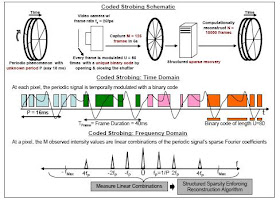
Khoa Luu let me know that Ramesh has actually crossed over to our side of the Force, he is now using compressive sensing to support the encoding and decoding of some of the truly innovative hardware he and others are hacking out. Today, Ashok Veeraraghavan , Dikpal Reddy , and Ramesh Raskar just released Coded Strobing Photography: Compressive Sensing of High-speed Periodic Events. The abstract reads;
We show that, via temporal modulation, one can observe a high-speed periodic event well beyond the abilities of a low-frame rate camera. By strobing the exposure with unique sequences within the integration time of each frame, we take coded projections of dynamic events. From a sequence of such frames, we reconstruct a high-speed video of the high frequency periodic process. Strobing is used in entertainment, medical imaging and industrial inspection to generate lower beat frequencies. But this is limited to scenes with a detectable single dominant frequency and requires high-intensity lighting. In this paper, we address the problem of sub-Nyquist sampling of periodic signals and show designs to capture and reconstruct such signals. The key result is that for such signals the Nyquist rate constraint can be imposed on strobe-rate rather than the sensorrate. The technique is based on intentional aliasing of the frequency components of the periodic signal while the reconstruction algorithm exploits recent advances in sparse representations and compressive sensing. We exploit the sparsity of periodic signals in Fourier domain to develop reconstruction algorithms that are inspired by compressive sensing.

The project page is here. For the moment one can find the following:
- Teaser Slide
- Short Presentation
- Video (69MB)
I'll add it shortly to the compressive sensing hardware page. As a side note, I wish we had that type of hardware when we were doing high-speed video of two-phase flow under microgravity. I mean the first time, it's cute, you think you have the lighting right, but in fact this is often not the case. You then have to redo the set-up every time you fly to get it right. Often the result was less than impressive even though you thought you designed your experiment right in the lab. An approximate set up is good enough to recognize most flow regimes, but this is barely the case in some instances. What you see in the following video are low flow rates, but as soon as the flow rate was increased ten fold, we had to resort to a tape based extremely expensive high speed Kodak system.
And let's not talk about the fact that our powerful lighting used to blow some of the fuses of the electrical system of Weightless wonder IV now on display at Ellington Field. Remember when your mother said 'Things could be worse" and sometimes, when the hydraulics would begin to fail, depressurization would occur or you would hear loud bangs on the left wing as we initiated a 6000 feet climb (albeit not in the same flight), you kind of thought, "Well...it IS worse, why am I doing this again ?" :)
Ramesh continues to advertize for people to join his group:
Thanks Khoa !
Ramesh continues to advertize for people to join his group:
We are actively looking for Graduate Students, MEng, PostDocs and UROPs starting Spring and Fall 2010. Please see here if you are interested.
Thanks Khoa !
No comments:
Post a Comment